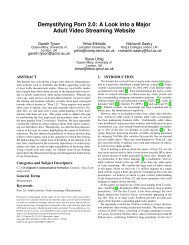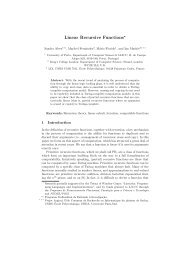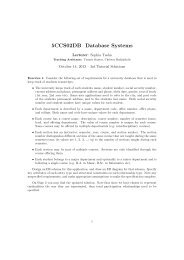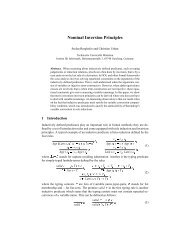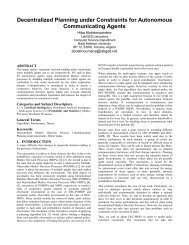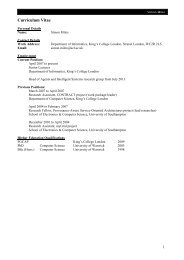Upgrade Report - Department of Informatics - King's College London
Upgrade Report - Department of Informatics - King's College London
Upgrade Report - Department of Informatics - King's College London
- No tags were found...
You also want an ePaper? Increase the reach of your titles
YUMPU automatically turns print PDFs into web optimized ePapers that Google loves.
8 EXISTING DATA SET ANALYSIS 28From what we can observe in the Figures 14 is that there is indeed the common characteristic <strong>of</strong> apower-law degree distribution. The co-efficient <strong>of</strong> this distribution seems to be a distinct characteristic <strong>of</strong>these networks or categories <strong>of</strong> networks but in general, the web-graph seems to have a co-efficient <strong>of</strong> c = 3which agrees with the web-graph model suggested by Cooper et al [13–15]. However some <strong>of</strong> the socialnetworks seem to have a co-efficient c < 2 which is hard to reproduce with existing generative models.8.2.2 Degree-Based Cut ConductunceFor the following plots it is worth clarifying what is actually drawn. The main idea <strong>of</strong> the plots is conductunceφ however our main interest is the conductance <strong>of</strong> between subsets <strong>of</strong> the graph which are partitioned basedon their degree.Assuming a graph G = {V, E} we denote as G[S] the subgraph induced from a vertex set S ∪ V and allthe edges e{u, v} : u, v ∈ S. In our case we define the following set <strong>of</strong> partitions:S(a) = {u : d(u) ≥ |V | a }G a = G[S(a)]The plot presented below are a on the x-axis and the conductance φ between the sets S(a) and VS(a) using the same formula defined in Equation 4.6.Figure 15: Degree-Based Cut ConductanceIn Figure 15 we can see the conductance <strong>of</strong> various real world networks compared to manufacturednetworks. From the plot we can infer that for the areas that each real world network carries a different plotand we may consider this as an indication <strong>of</strong> how well vertices <strong>of</strong> specific degrees connect between themselves.For example, the SlashDot Zoo networks when compared to preferential attachement graphs, show a muchbetter (lower) conductance at reasonably high degrees, we do not consider extreme cases <strong>of</strong> very very highdegrees as those cases usually include one or two isolated vertices. What this means in SlashDot is that(reasonably) high degree vertices are better inter-connected than we can expect in a preferential attachmentnetwork. This may indicate additional features in the generative process <strong>of</strong> these networks which is arenot limited to preferential attachment. It is <strong>of</strong> interest to us to perform additional measurements in othergenerated networks to determine how well they compare. However another interesting observation we canmake is networks such as LiveJournal and Google have a bad conductance at reasonably high degrees



